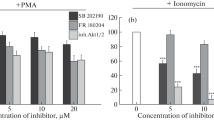Abstract
Protein kinase C (PKC) plays a crucial role in receptor-mediated signal transduction affecting a diverse range of cellular responses such as cell proliferation, differentiation, and tumor promotion. PKC is known to be activated by calcium ion and lipids such as phosphatidylserine and 1,2-diacylglycerol, and directly by phorbol 12-myristate 13-acetate (PMA). We have recently reported that 1,2-dilinoleoylglycerol hydroperoxide (1,2-LLG-OOH) and hydroxide (1,2-LLG-OH) activate PKC isolated from rat brain almost as efficiently as does PMA.1 1,2-LLG-OOH and 1,2-LLG-OH can activate PKC even in the absence of calcium ion and phosphatidylserine.1 It is therefore suggested that 1,2-diacylglycerol hydroperoxide (1,2-DAG-OOH) and hydroxide (1,2-DAG-OH) may activate the PKC-dependent signal transduction system if these components are released from oxidized biomembranes by the action of phospholipase C.1 Recently, we have demonstrated that oxidized 1,2-diacylglycerol can act as a biochemical messenger in cellular systems by showing that 1,2-DAG-OOH activates human polymorphonuclear leukocytes (PMNs).2 The activation of PMNs was assessed by measuring the Superoxide anion released from PMNs. The production of Superoxide anion was measured by a chemiluminescence method using a sea-firefly cypridina luciferin analogue, 2-methyl-6-(p-methoxyphenyl)-3,7-dihydroimidazo [1, 2-a] pyrazin-3-one (MCLA), as a luminescence reagent. 3
Access this chapter
Tax calculation will be finalised at checkout
Purchases are for personal use only
Preview
Unable to display preview. Download preview PDF.
Similar content being viewed by others
References
S. Takekoshi, Y. Kambayashi, H. Nagata, T. Takagi, Y. Yamamoto, and K. Watanabe, Activation of protein kinase C by oxidized diacylglycerols, Biochem. Biophys. Res. Commun. 217:654 (1995).
Y. Yamamoto, Y. Kambayashi, T. Ito, K. Watanabe, and M. Nakano, 1,2-Diacylglycerol hydroperoxides induce the generation and release of Superoxide anion from human polymorphonuclear leukocytes, FEBS Lett. 412:461 (1997).
M. Nakano, Determination of Superoxide radical and singlet oxygen based on chemiluminescence of luciferin analogs, Methods Enzymol. 186:585 (1990).
Y. Yamamoto, M. H. Brodsky, J. C. Baker, and B. N. Ames, Detection and characterization of lipid hydroperoxides at picomole levels by high-performance liquid chromatography, Anal. Biochem. 160:7 (1987).
Y. Nagata, Y. Yamamoto, and E. Niki, Reaction of phosphatidylcholine hydroperoxide in human plasma: The role of peroxidase and lecithinxholesterol acyltransferase, Arch. Biochem. Biophys. 329:24 (1996).
H. Rosen and S. J. Klebanoff, Chemiluminescence and Superoxide production by myeloperoxidase-deficient leukocytes, J. Clin. Invest. 58:50 (1976).
M. Nakano, K. Sugioka, Y. Ushijima, and T. Goto, Chemiluminescence probe with cypridina luciferin analog, 2-methyl-6-phenyl-3,7-dihydroimidazo[l,2-a]pyrazin-3-one, for estimating the ability of human granulocytes to generate 02-, Anal. Biochem. 159:363 (1986).
J.M. McCord and I. Fridovich, Superoxide dismutase, J. Biol. Chem. 244:6049 (1969).
M. Lucas, V. Sanchez-Margalet, C. Pedrerea, and M.L. Bellido, A chemiluminescence method to analyze phosphatidylcholine-phospholipase activity in plasma membrane preparations and in intact cells, Anal. Biochem. 231:277 (1995).
C.R. Wagner and N. A. Porter, A phospholipase C protocol for phospholipid peroxidation analysis, Chem. Res. Toxicol. 1:274 (1988).
Y. Kambayashi, S. Yamashita, E. Niki, and Y. Yamamoto, Oxidation of rat Liver phospholipids: Comparison of pathways in homogeneous solution, in liposomal suspension and in whole tissue homogenates, J. Biochem. 121:425 (1997).
B Frei, R. Stocker, and B. N. Ames, Antioxidant defenses and lipid peroxidation in human blood plasma, Proc. Natl. Acad. Sci. USA 85:9748 (1988).
C. Ji and L. J. Marnett, Oxygen radical-dependent epoxidation of (7S,8S)-dihydroxy-7,8-dihydrobenzo[a]pyrene in mouse skin in vivo, J. Biol. Chem. 267:17842 (1992).
Y. Yamamoto and S. Yamashita, Plasma ratio of ubiquinol and ubiquinone as a marker of oxidative stress, Molec. Aspects Med. 18:s79 (1997).
Y Yamamoto, H. Sone, S. Yamashita, Y. Nagata, H. Niikawa, K. Hara, and M. Nagao, Oxidative stress in LEC rats evaluated by plasma antioxidants and free fatty acids, J. Trace Elem. Exp. Med. 10:129 (1997).
N Ames, L. S. Gold, and W. C. Willett, The causes and prevention of cancer, Proc. Natl. Acad. Sci. USA 92:5258 (1995).
Author information
Authors and Affiliations
Editor information
Editors and Affiliations
Rights and permissions
Copyright information
© 1999 Springer Science+Business Media New York
About this chapter
Cite this chapter
Yamamoto, Y., Kambayashi, Y., Ito, T., Watanabe, K., Nakano, M. (1999). 1,2-Diacylglycerol Hydroperoxide Induces the Generation and Release of Superoxide Anion from Human Polymorphonuclear Leukocytes. In: Honn, K.V., Marnett, L.J., Nigam, S., Dennis, E.A. (eds) Eicosanoids and Other Bioactive Lipids in Cancer, Inflammation, and Radiation Injury, 4. Advances in Experimental Medicine and Biology, vol 469. Springer, Boston, MA. https://doi.org/10.1007/978-1-4615-4793-8_63
Download citation
DOI: https://doi.org/10.1007/978-1-4615-4793-8_63
Publisher Name: Springer, Boston, MA
Print ISBN: 978-1-4613-7171-7
Online ISBN: 978-1-4615-4793-8
eBook Packages: Springer Book Archive




